6 October 25
Jazz Band
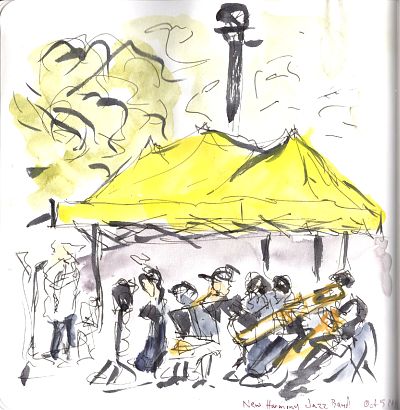 This is my urban sketch for this past Sunday. I went over to Central Park where the biweekly Davis Craft & Vintage Fair was taking place. The local New Harmony Jazz Band was playing at one end of the fair, as they often do.
This is my urban sketch for this past Sunday. I went over to Central Park where the biweekly Davis Craft & Vintage Fair was taking place. The local New Harmony Jazz Band was playing at one end of the fair, as they often do.
I am getting used to sketching in this 7”×7” sketchbook. It’s a little bigger than what I’ve been sketching in previously, but this lets me be freer with the sketches. I like the combination of fountain pen fine line work with a gray Pentel brush for bolder ink strokes. I am still pleased with the Derwent line and wash kit. It was nice to have that bold Inktense yellow handy for the tent canopy. And I figured out how to mix skin tones with the paint pan set: I used a combination of poppy red with the mango Inktense colors.
5 October 25
The Call of the Loon
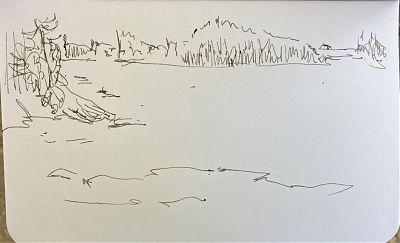 This past week has been very busy with getting things packed up, distributed to various places, visits to lawyers and accountants and funeral homes, all the kinds of things that need to be done and nobody much feels like doing.
This past week has been very busy with getting things packed up, distributed to various places, visits to lawyers and accountants and funeral homes, all the kinds of things that need to be done and nobody much feels like doing.
We did take a break, though, on Friday morning, to distribute mum’s ashes along with the remaining ones of my father. As we walked silently back to the car, a couple of loons began to call.
Mum kept her sense of humor to the end: writing “sayonara” on her calendar to all future doctor’s appointments, she really left on her terms and on her schedule. I will be making a donation to Maine’s Death With Dignity foundation.
4 October 25
Discovering A Prophet
I had a meaningful Yom Kippur this week, and through some supplemental reading (the group the Halachic Left’s collection of essays for this year’s High Holy Days) I discovered a Jewish theologian I need to dive into, namely Marc H. Ellis. He was one of first people to develop a Jewish liberation theology, especially in the context of Palestine. The notion that Jewish liberation can only come about through the liberation of the Palestinian people is a theology that traces back to Ellis, who started writing about these themes in the 1980s. (He died in June 2024).
It is not surprising I have not heard about him before; his work has been shunned by mainstream Judaism. This essay by Zev Mishell introduced me to him. I particularly like his concept of “Constantinian Judaism”, which is to say that Judaism is now a religion of empire. There was also a series of remembrances of Ellis written up in Contending Modernities, a web publication from the University of Notre Dame.
Lots to read as always.
2 October 25
New Water Year
 Because most of precipitation in California falls during fall and winter, state hydrologists start the record-keeping for the annual amount of precipitation on October 1st of each year. This past year, the 2025 water year, we got 13.13 inches of rain at our house, which is a pretty dry year. October has started out with a little bit of rain already: yesterday (1 October) we got 0.02 inches of rain and today we got 0.20 inches at our house. I even felt the need to wear my rain jacket and pants for a little walk this morning.
Because most of precipitation in California falls during fall and winter, state hydrologists start the record-keeping for the annual amount of precipitation on October 1st of each year. This past year, the 2025 water year, we got 13.13 inches of rain at our house, which is a pretty dry year. October has started out with a little bit of rain already: yesterday (1 October) we got 0.02 inches of rain and today we got 0.20 inches at our house. I even felt the need to wear my rain jacket and pants for a little walk this morning.
30 September 25
Convivencia
Having recently gotten interested in the world of the Catalan medieval rabbi Nachmanides (aka Moses ben Nachman aka Ramban aka Bonastruc ça Porta), I just read the 2002 book The Ornament of the World: How Muslims, Jews and Christians Created a Culture of Tolerance in Medieval Spain, by María Rosa Menocal. I was initially deterred from reading it by some disappointing reviews, but I dived in anyway and quite liked it. It is not a scholarly history nor was Menocal a historian: she was a scholar of medieval Iberian literature, and the book is at its best tracing the world of translators and connections between Arabic, Hebrew, and Romance poetry and poetic forms. There is a 2019 PBS documentary based on the book; I will watch it one of these days.
I looked at some of the reaction to this book and came across a Wikipedia entry for a book entitled https://en.wikipedia.org/wiki/The_Myth_of_the_Andalusian_Paradise by Dario Fernández-Morera. But reading to the bottom of the entry led me to one of the most scathing academic reviews I have run into, entitled The Myth of the Myth of the Andalusian Paradise: The Extreme Right and the American Revision of the History and Historiography of Medieval Spain, by S.J. Pearce, who is a professor in the Department of Spanish and Portuguese at New York University. Thus I stumbled into a war between liberal and far-right historiography, between convivencia and reconquista. Here are some choice quotes from S.J. Pearce:
By cherry-picking evidence, relying on outdated and explicitly partisan scholarship, adopting a messianic and omniscient authorial voice, and misrepresenting his opponents in order to argue against straw men he can vanquish rather than flesh-and-blood ones he cannot, Fernández-Morera uses the case of medieval Spain to further an explicitly extreme right-wing political and conservative Christian political and cultural agenda as it bears upon debates about politics, the establishment of religion, and the very place of the academy in civic life.
and
In addition to criticizing liberal ideas and values, Fernández-Morera situates his historiographical approach on the political new right through his explicit aim of vindicating Spain’s Catholic past in a way that closely mirrors and brings to an Anglophone audience the historiographical jiu-jitsu of Francisco Franco’s nationalist dictatorship, which is articulated clearly in the preamble to the Law of November 24, 1939 Creating the Spanish National Research Council. This law, signed into effect by Franco himself, establishes the council in order to defend Spanish history against Enlightenment thought and the diversity of opinion.
I feel vindicated in reading Menocal, and will follow up with some of her suggested readings.
28 September 25
Mantis At Work
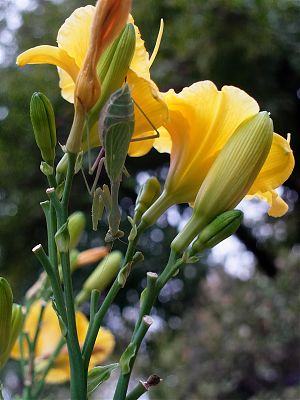 Our neighbor Barbara this afternoon showed me this praying mantis in her front yard. It has been hanging out in these lilies for a few days now, and the other day she spotted it devouring a bumblebee attracted to the flowers. It’s a good place to work, I suppose.
Our neighbor Barbara this afternoon showed me this praying mantis in her front yard. It has been hanging out in these lilies for a few days now, and the other day she spotted it devouring a bumblebee attracted to the flowers. It’s a good place to work, I suppose.
27 September 25
Goodbye
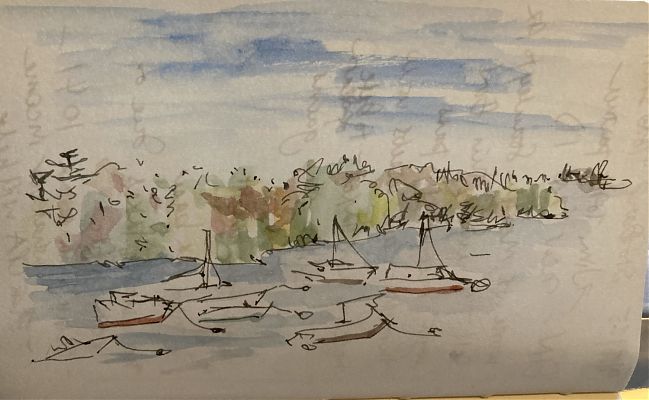 Yesterday we took my mother to Paul’s Marina on Mere Point Road in Brunswick. We sat outside and watched the ospreys fishing, the boats turning into the incoming tide, and my mother greedily eating two scoops of peanut butter pie ice cream.
Yesterday we took my mother to Paul’s Marina on Mere Point Road in Brunswick. We sat outside and watched the ospreys fishing, the boats turning into the incoming tide, and my mother greedily eating two scoops of peanut butter pie ice cream.
This morning, she was gone, surrounded by all of us and doing it exactly like she wanted.
Farewell, mum, good travels. I have so much to thank you for. (Not sure who I’ll call now with bridge questions, but we’ll manage.)
26 September 25
The Line And Wash Kit
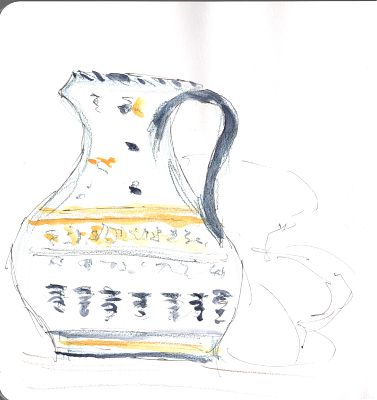 With this new sketchbook I have switched out some of my sketching kit. I am a big fan of Derwent art supplies and for my previous sketchbook I was working a lot with the Derwent Graphitint pan set. This is a watercolor pan set with graphite mixed into the color pans making for muted colors. I have now changed this out back to the Derwent line and wash paint pan set, which is the first paint pan set I got from Derwent.
With this new sketchbook I have switched out some of my sketching kit. I am a big fan of Derwent art supplies and for my previous sketchbook I was working a lot with the Derwent Graphitint pan set. This is a watercolor pan set with graphite mixed into the color pans making for muted colors. I have now changed this out back to the Derwent line and wash paint pan set, which is the first paint pan set I got from Derwent.
I am giving the line and wash pan set a solid recommendation. It provides an extremely well chosen set of colors and varieties of paint for urban sketching. Specifically, it has 6 Inktense pans (sun yellow, mango, poppy red, bright blue, Payne’s gray, and natural brown), 4 Graphitint pans (meadow, autumn brown, port, and ocean blue), and two pastel pans (artichoke and storm gray). The Inktense pans provide dashes of brilliant color, the Graphitints give more muted colors, and the pastel pans are opaque and gouache-like. The kit also comes with a couple of black waterproof fine point line markers.
The sketch here of a jug in our living room shows a wash with the Inktense sun yellow and the Payne’s gray.
25 September 25
Collective Revisiting
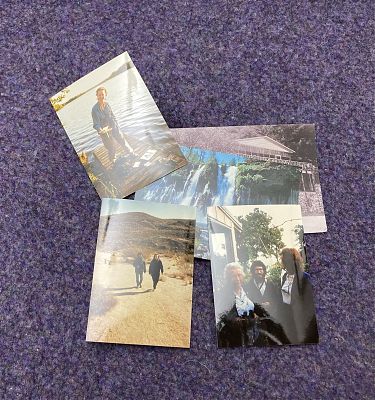 Looking through hundreds of old photos with three generations of family members is an interesting experience. Perspectives change, what’s important changes, so many details are now lost to history…But we had a great time this afternoon sorting through some of my mother’s photos. There are more to go, but for now we are savoring the time we have with her, mining her memory and adding ours.
Looking through hundreds of old photos with three generations of family members is an interesting experience. Perspectives change, what’s important changes, so many details are now lost to history…But we had a great time this afternoon sorting through some of my mother’s photos. There are more to go, but for now we are savoring the time we have with her, mining her memory and adding ours.
The photos above are the prints I’m keeping so far. I already have a lot of photos of our camping trips and of my parents in Bodega Bay and Spain. In this age where digital photos are at the end of your thumb and a smartphone, the magic of seeing old prints was a joy. More anon.
24 September 25
One Eagle Hill
I finally finished reading Kai Bird and Martin Sherwin’s biographical tome about J. Robert Oppenheimer, American Prometheus. One of the things that draws me into the Oppenheimer story, both this book and the blockbuster movie of a couple years back, is that my family history intersects quite strongly with the places, the people, and the science in the narrative. Both my parents studied chemistry as undergraduates at Ohio State University, and they moved out to the Berkeley area in 1948 when my father started graduate studies in nuclear chemistry at UC Berkeley. His major professor was Glenn T. Seaborg, who in 1940 discovered plutonium and worked on the element’s chemical extraction at the Metallurgical Laboratory at the University of Chicago during the Manhattan Project. Seaborg knew most everyone in the Oppenheimer story, and because Berkeley became the premier center for nuclear chemistry, my father met some of these scientists as well.
Oppenheimer came to UC Berkeley around 1929 to develop a research program in theoretical physics. An article in the magazine Berkeleyside that came out around the movie illustrates the places that figured in Oppenheimer’s time at Berkeley. Two of these places I know well. Around 1940 the Oppenheimers rented a house at 10 Kenilworth Court in Kensington. I know this place because it was just around the corner from where chemistry professor Joel Hildebrand lived. Hildebrand lived to be 101, and when I would walk to high school in the late 1970s I would sometimes see Professor Hildebrand ambling about near there. (Also, scholarly longevity can be a family thing I guess. Joel Hildebrand’s son Milton became a distinguished zoologist and professor here at UC Davis. Milton died in 2020 at the age of 102).
The Oppenheimers then bought a house at One Eagle Hill Road in 1941. This house is 75 yards away from the home on Edgecroft Road where I grew up and my sister still lives. My parents bought the Edgecroft house in 1953 by which point the Oppenheimers had already moved away, but it’s fun to think about the coincidence in space if not in time. As a kid I played up and on the hill a stone’s throw away from where the Chevalier incident took place (Oppenheimer’s conversation in 1943 with his close friend Haakon Chevalier that would lead to Oppenheimer’s downfall in the 1954 security clearance hearings).
There’s a detail in the Berkeleyside article is of interest to Davis folks. When Oppenheimer moved to Los Alamos in March 1943 to lead the atomic bomb research there, he rented out the Eagle Hill house to a food scientist at UC Berkeley by the name of Emil Mrak. Mrak would go on to start the food science program at UC Davis and then became chancellor in 1959. The administration building at UC Davis is named Mrak Hall after him.
A final astronomical note. I remember looking at Comet Kohoutek through binoculars probably in January 1974 from the top of Eagle Hill. Kohoutek was not the spectacle people hoped for, but it was still fun to see.
